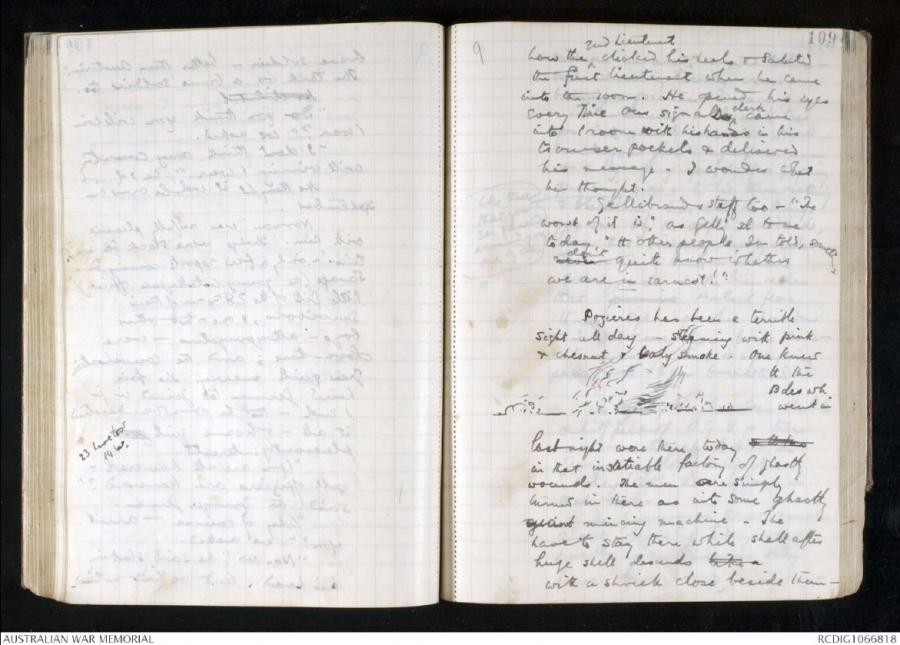Fromelles and Pozières

Fromelles and Pozières
On 19 July 1916 the Australians attacked at Fromelles, with disastrous results. The Australians suffered a shocking 5,500 casualties – their greatest losses in a single day. It was a harsh lesson about the scale and intensity of warfare on the Western Front.
Four days later, Australians went into action on the Somme, attacking and capturing Pozières. Under heavy bombardment, casualties grew over the next few weeks, eventually totalling 23,000.
Fighting continued on the Somme through the autumn mud and a bitterly cold winter. Australian casualties continued to mount, and the men’s health deteriorated in the conditions.
Men of the 53rd Battalion in a trench in their front line a few minutes before the launching of the attack at Fromelles. H16396
"Pozières has been a terrible sight all day … The men were simply turned in there as into some ghastly giant mincing machine. They have to stay there while shell after huge shell descends with a shriek close beside them … each shrieking tearing crash bringing a promise to each man – instantaneous – I will tear you into ghastly wounds – I will rend your flesh and pulp an arm or a leg – fling you half a gaping quivering man (like those that you see smashed around you one by one) to lie there rotting and blackening like all the things you saw by the awful roadside, or in that sickening dusty crater."

Captured German trenches near the windmill at Pozières, the most elevated point in the area, and the scene of bitter fighting and heavy bombardment. The more the trenches were shelled, the shallower and wider they became, offering less protection.
“My tunic is rotten …”
"We are lousy, stinking, ragged, unshaven and sleepless. Even when we’re back a bit we can’t sleep for our own guns. I have one puttee, a dead man’s helmet, another dead man’s gas protector, a dead man’s bayonet. My tunic is rotten with other men’s blood, and partly splattered with a comrade’s brains. It is horrible, but why should you people at home not know? Several of my friends are raving mad. I met three officers out in No Man’s Land the other night, all rambling and mad. Poor Devils!."
The old German lines at Pozières, looking north towards the windmill. These positions were captured by the 2nd Division on 4 August 1916.
A Pattern 07 British bayonet and scabbard found near Pozières. Bayonets were not often used in trench warfare, but the occasion when Private John Leak won a Victoria Cross by charging a German bomb post at Pozières was an exception. Seconds later, Leak’s officer saw him emerge wiping blood from his bayonet onto his slouch hat.
“The hour approacheth”
"Today I lead my battalion in an assault on the German lines and I pray God that I may come through alright and bring honour to our name. If not I will at least have laid down my life for you and my country, which is the greatest privilege one can ask for. Farewell dear people, the hour approacheth.!."
McCrae went “over the top” with his battalion and was killed, shot through the neck, early in the battle.
Private Raymond Pflaum
"While the men were getting their wind, my attention was drawn to a wounded man alongside of me just along a dugout. It was Ray … He was quite conscious and by his appearance didn’t seem to be hit too badly … I managed to get him a flask of whisky … and a mouthful of that seemed to make his spirits go up … I asked a 32nd fellow … to do his best for Ray while he could. I then made my way down to find a position for my gun.."
Corporal Theodor Pflaum, 8th Machine Gun Company, 19 July 1916
Private Raymond Pflaum of the 32nd Battalion was killed at Fromelles. His brother, Theodor, found him wounded on the battlefield but could not stop long enough to help him. Raymond died of his wounds later that day. His body was not recovered until 2010, when his remains were found during the excavation of a mass grave at Pheasant Wood.





